Physical Address
304 North Cardinal St.
Dorchester Center, MA 02124
A variety of untoward events may befall the developing infant while in utero or postpartum. Some of these perinatal problems are inherent in the birth process. Others are related to technologic advances that have become standard obstetric and nursery practice. Although these diagnostic and therapeutic procedures have reduced morbidity and mortality, some also pose a significant risk for iatrogenic complications. Sequelae of iatrogenic complications can also present later in infancy or early childhood. Moreover, iatrogenic and traumatic injuries can occur in older infants. This chapter emphasizes those occurring in neonates and young infants. More extensive discussions of non-accidental injury (more common in older infants) can be found in other textbooks.
Amniocentesis is currently the most widely used technique for the antenatal diagnosis of genetic disorders. Although routinely a second-trimester procedure, it may also be performed in the third trimester for management of isoimmunization or evaluation of fetal maturity, or late in the first trimester for fetal karyotyping and DNA analysis. The risk of damage to the fetus is quite low, particularly in the middle trimester; nevertheless, needle puncture of the skin and sometimes of the underlying structures is a possible complication. Estimates of the incidence of cutaneous scarring ranged as high as 9% in the 1970s; however, with increased experience and the advent of real-time ultrasonography, this figure has dropped to less than 1%. Despite the benignity of the procedure, the incidence of fetal injury rises dramatically with an increasing number of needle passages at amniocentesis.
Amniocentesis scars are depressed, dimple-like lesions that usually measure 1–5 mm in diameter, although scars as large as 12 mm in diameter and 8 mm in depth have been documented ( Fig. 8.1 ). They may be solitary or multiple, and are often inconspicuous. Shallow linear lesions have also been described. Although sometimes present at birth, they are often not noticed until the infant is several weeks to months old. The most frequent sites of injury are the extremities, followed by the head, neck, and chest. Mid-trimester amniocentesis has the lowest risk of puncture because the fetus occupies only about 50% of the amniotic cavity; in both the first and third trimesters, there is less room to maneuver, and sudden movements of the fetus may make injury unavoidable.
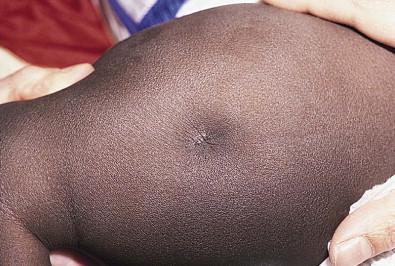
Amniocentesis scars must be differentiated from congenital sinus tracts, aplasia cutis, focal dermal dysplasia, amniotic band syndrome, accessory nipples, and dimples associated with congenital rubella, diastematomyelia, Bloom syndrome, and cerebrohepatorenal syndrome.
Chorionic villus sampling (CVS), which can be performed early in the first trimester, is the preferred procedure for patients at risk for certain single gene disorders. The technique yields mitotically active cells suitable for rapid DNA analysis and permits detection of placental mosaicism. Of concern, however, are reports of increased risk of limb and jaw malformations as well as an increased risk of infantile hemangiomas, particularly in fetuses undergoing CVS at <9 weeks' gestation. An analysis of 138 996 outcomes in a multicenter study disputes this notion but is not universally accepted, and thus the issue remains a controversial area still under study. A distinctive defect of absent distal third fingers with tapering of other digits, was more recently reported to be associated with exposure to CVS in a review by Golden and colleagues.
Intrauterine electronic monitoring of the fetal heart rate via a spiral electrode attached to the presenting part has become standard obstetric practice. Complications are infrequent and consist mainly of minor lacerations, ulcerations, scalp abscesses, and herpetic infections. Herpetic infections are extremely rare; however, incidence figures for scalp abscesses in monitored infants due to other agents, range from 0.1% to 5.4%, with most in the 0.3–0.5% range.
Scalp abscesses are localized collections of suppurative material that present as erythematous, indurated masses with or without fluctuance in the area of electrode application. Usually solitary, they vary in size from one to several centimeters. Onset can be as early as the first day or as late as the third week, but they are most frequently noted on the third or fourth day of life. Enlarged posterior cervical lymph nodes often accompany the abscess. Usually the inflammation remains confined to the skin; however, in a review of neonatal scalp abscesses by Weiner and coworkers, reported complications can include osteomyelitis, cellulitis, seizures, meningitis, brain abscess, bacteremia, and death. Contributing factors in some series (but not others) appear to be high-risk pregnancy (prematurity), prolonged rupture of the membranes, and long duration of fetal heart rate monitoring. The presence of amnionitis does not seem to be correlated. Although an infectious cause has been disputed – because cultures obtained from some infants have been sterile – data from large series support the concept of an infectious etiology. Okada and colleagues reported on 42 infants with scalp abscess, 100% of whom had positive cultures: 85% were polymicrobial, 58% grew both aerobes and anaerobes, 33% grew aerobes only, and 9% grew anaerobes only. The predominant aerobic organisms were Staphylococcus epidermidis and Streptococcus groups A and B; the predominant anaerobes were Streptococcus and Peptococcus . A confirmatory study by Brook and Frazier demonstrated similar findings in 23 infants. Andrews and colleagues evaluated vaginal cultures from 5732 mothers and found the MRSA colonization rate to be 3.5%, with no cases of early-onset neonatal MRSA infection postpartum. It is critical to distinguish infants with intrapartum inoculation of herpes simplex virus (HSV) from neonates with a bacterial scalp abscess (see Chapter 13 ). Although HSV infection as a complication of scalp monitoring is distinctly uncommon, the outcome can be devastating, with permanent neurologic damage, or death from systemic disease. Both type 1, and type 2 infections have been documented; unfortunately, this complication may occur with asymptomatic shedding of the virus and in the absence of a history of overt clinical disease.
Scalp abscesses usually heal uneventfully but may leave minor degrees of scarring, hypopigmentation, and alopecia, causing confusion with aplasia cutis, nevus sebaceus, or focal dermal hypoplasia in later years.
Needle marks consisting of hypopigmented pinhead-size lesions, when presenting in large numbers, may impart a speckled appearance to the skin. These marks are due to venipuncture, arterial punctures, and catheter insertion, and are most commonly seen on the scalp, hands, wrists, feet, ankles, arms, and legs. Fox and Rutter reported an improvement in the appearance of needle marks by 9 years of age, in their cohort of 90 patients. Heel-pricks from blood sampling may cause dimpling or, rarely, calcified nodules (see below), hypertrophic scars, or even gangrene ( Fig. 8.2 ).
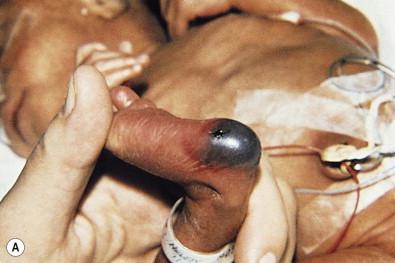
Injury to the soft tissues may occur in the setting of a prolonged labor because of cephalopelvic disproportion ( Fig. 8.3 ), or with forceps delivery. Erythema, abrasions, and forceps marks are most common over the face, but rarely cause significant injury, and usually resolve spontaneously ( Fig. 8.4 ).
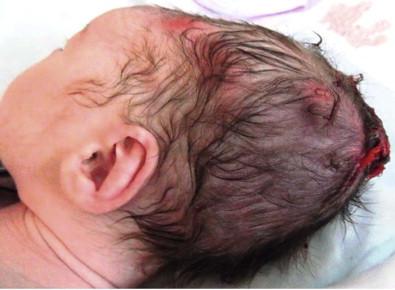
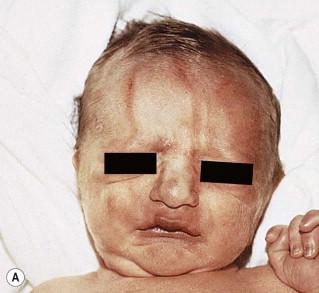
Petechiae on the head, neck, and upper body are likely to be caused by pressure differences that occur during passage of the chest through the birth canal. It is important to exclude the possibility of an underlying infection or hematologic disorder with appropriate laboratory studies. Petechiae caused by trauma are innocuous and usually fade within 2–3 days.
Ecchymoses may be extensive following a traumatic or breech delivery. Large areas of bruising may result in hyperbilirubinemia, requiring phototherapy. Ecchymoses resolve gradually, but may take up to several days to disappear completely.
Diffuse edematous swelling of the scalp, when it is the presenting part, is known as caput succedaneum. Extravasation of blood or serum above the periosteum occurs as a result of venous congestion caused by pressure of the uterus, cervix, and the vaginal wall on the infant's head during a prolonged or difficult labor and delivery. Because the accumulation of fluid is external to the periosteum, it crosses the midline and is not limited by the suture lines. If labor is prolonged, petechiae, purpura, and ecchymoses, as well as molding of the head and overriding sutures, may be prominent features. Unlike cephalhematoma, with which a caput is occasionally confused, the skin findings resolve within a few days. The molding may take a few weeks to disappear. Occasionally, if severe, tissue necrosis and a localized area of scarring alopecia may ensue.
Cephalhematoma is caused by rupture of the emissary or diploic veins of the skull during a prolonged or difficult labor or delivery. The result of subperiosteal hemorrhage, it differs clinically from caput succedaneum in that it is almost always unilateral. The hematoma is localized most often to the area over the parietal bone, and the mass is confined by the periosteum, which adheres to the margin of the bone ( Fig. 8.5 ). Cephalhematoma less frequently involves the occipital bones, and only rarely the frontal bones. If both parietal bones are involved, the hematomas are sharply demarcated and separated by a midline depression corresponding to the intervening suture. The overlying scalp is not discolored.
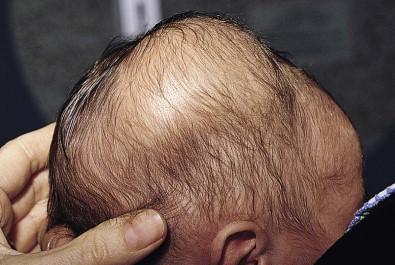
Cephalhematomas are seen more commonly in vacuum-assisted vaginal deliveries than in forceps or spontaneous births. The swelling may not become apparent until several hours to days after birth. As the hematoma ages, it develops a calcified rim and is gradually completely overlaid with bone. Estimates of underlying skull fractures have ranged from 5.4% to 25%. Differential diagnosis includes caput succedaneum and cranial meningocele. Meningoceles can be differentiated by the presence of pulsations, increased pressure when crying, and the presence of a bony defect on X-rays. Infection of the mass and severe hemorrhage resulting in anemia and hyperbilirubinemia are rare complications for which antibiotics, blood transfusions, and phototherapy may be required. Treatment is unnecessary for uncomplicated lesions. Most cephalhematomas are resorbed during the first few weeks of life and are of no consequence. Occasionally, they calcify and persist for months to years.
Subgaleal hemorrhage is a rare but potentially life-threatening complication that occurs when emissary veins are ruptured, most commonly by instrumentation at delivery. Like cephalhematomas, vacuum-assisted delivery increases the incidence of subgaleal hemorrhage. Bleeding into the loose connective tissue of the subgaleal (also known as the subaponeurotic) space can be extensive, leading to severe anemia, disseminated intravascular coagulation (DIC) and hypovolemic shock. The area of swelling crosses suture lines and can extend from the brow line to the nape, as well as laterally to the temporal fascia located behind the ears. Unlike cephalhematomas, which are limited by the periosteum and suture lines, the aponeurotic space may accommodate up to 260 mL of blood, approaching the circulating blood volume of a neonate, which is approximately 80 mL/kg. Physical assessment may reveal dependent swelling on the scalp that varies from firm to fluctuant, and fluid waves may be present when the area is palpated. The neonate may exhibit hypotonia, pallor and tachypnea. As hypovolemia worsens, signs of poor perfusion, tachycardia, oliguria, and eventually hypotension may ensue. The infant must be closely monitored for signs and symptoms of neurologic compromise, shock and bleeding. Treatment is aimed at maintaining normovolemia, and controlling coagulopathy.
The formation of some type of hematoma is a common occurrence with the use of a vacuum extractor, although with the introduction of softer silicone cups, the risk has been reduced. A ‘chignon,’ or artificial caput succedaneum, is created by adherence of the cup to the scalp and is most obvious immediately following removal of the cup. However, the swelling usually disperses relatively rapidly after birth. If a chignon is formed in the presence of a natural caput, the scalp may have a boggy sensation suggesting subgaleal hemorrhage (see above).
Cephalhematomas, a ring of suction blisters, lacerations, and abrasions may also result from the use of the vacuum extractor. The latter are usually the result of prolonged traction and sudden detachment of the cup. Subcutaneous emphysema of the scalp has been attributed to vacuum extraction in an infant with a coexistent scalp electrode wound.
Cases of vesicular eruptions following vacuum extraction with or without the presence of herpes simplex virus ( Fig. 8.6 ) have been reported, presumably from the combination of mechanical trauma and colonization.
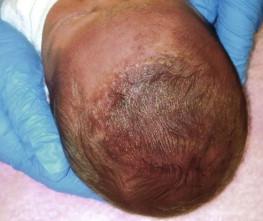
Alopecia in an annular configuration, presumably the consequence of localized injury during the birth process, has been referred to as ‘halo scalp ring’ injury. Often – but not always – there is a history of a prolonged labor. The hair loss is manifest at birth, or shortly thereafter, as a band of alopecia ranging in width from 1 to 4 cm, usually located over the vertex ( Fig. 8.7A ). There is typically an associated caput succedaneum and in some instances, frank tissue necrosis ( Fig. 8.7B ). If the injury is mild, the alopecia is usually temporary; however, scarring alopecia may result if the injury is severe ( Fig. 8.7C ). The areas of scarring can often be corrected with plastic surgery. The presence of halo scalp ring implies soft-tissue hypoxia and as such, infants with this condition should be monitored for developmental defects, which could have accompanied prolonged labor and associated hypoxic states.
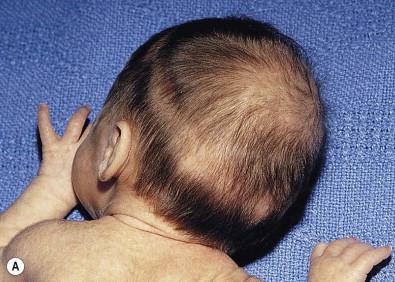
Scalpel lacerations to the infant during cesarean section represent a potential form of injury. Smith and coworkers found an incidence of fetal injury of 1.9% in a series of 896 cesarean deliveries. Lacerations were much more common in those deliveries where the indication was nonvertex presentation (breech or transverse lie). In these infants, the injuries were almost always located on the lower portion of the body, whereas infants in a vertex presentation usually sustained their lacerations on the head. Failure to recognize the injury in the delivery room was a common occurrence.
Become a Clinical Tree membership for Full access and enjoy Unlimited articles
If you are a member. Log in here